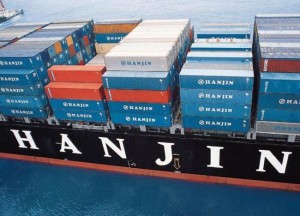Some five months after the collapse of Korean shipping group Hanjin Shipping, more than two-thirds of all Hanjin-operated containerships remain inactive, according to shipping consultancy Drewry.
Although a number of ships was auctioned for a total of USD 460 million so far, Drewry estimates that there remains up to as much as 150,000 TEU of Hanjin-owned ships still for sale.
Hanjin’s demise exposed the frailty of container lines in an era of ultra-low freight rates and caused panic among cargo owners with assets aboard their ships. After the logistical chaos has been cleared up, what has happened to those vessels?
An immediate impact could be seen on the containership idle fleet, which surged after 98 ships with an aggregate capacity of around 610,000 TEU were suddenly left without employ. The idle fleet went from 904,000 TEU in mid-August to 1.7 million TEU in mid-November.
The declining stature of the idle fleet from December onwards is in large part due to some of those ex-Hanjin ships being re-chartered.
Four vessels of 15,000 TEU in total have been scrapped, two of which were owned by Hanjin and none older than 20 years, while another 31 ships of 134,000 TEU have found new service elsewhere.
Non-operating charterers have managed to find replacement lessors for 30 ships so far. Maersk Line has shown the biggest appetite for the former Hanjin fleet by chartering 11 vessels of 77,000 TEU, the largest being two 13,000 TEU units that were sold at auction to unnamed buyers in December for around USD 131 million apiece, according to unconfirmed media reports. Maersk is deploying the vessels in the 2M Alliance Asia-Europe network.
There remain some 63 ex-Hanjin ships with close to 460,000 TEU worth of nominal capacity that are parked up. At least eight vessels should be back on the water fairly quickly.
With such a glut of containerships already available and limited demand growth it is debatable just how big a market they can attract even at knock-down prices. The biggest and youngest ships are likely to have the biggest pull, according to Drewry.
Copyright Ships & Ports Ltd. Permission to use quotations from this article is granted subject to appropriate credit given to www.shipsandports.com.ng as the source.
